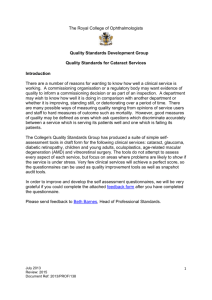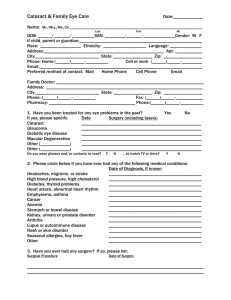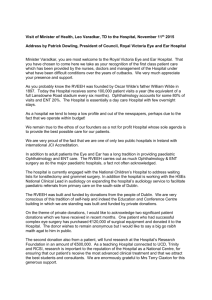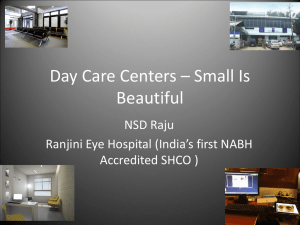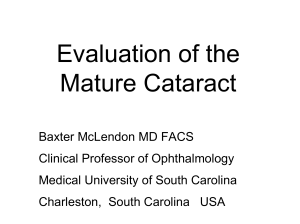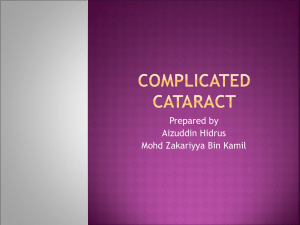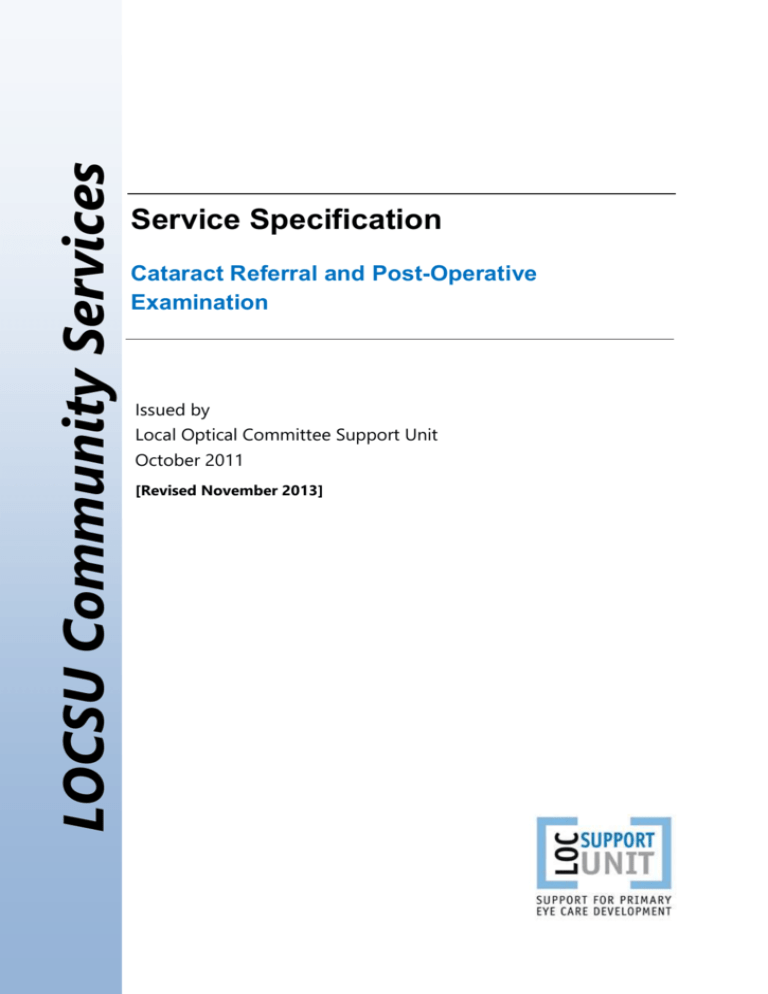
LOCSU Community Services
Service Specification
Cataract Referral and Post-Operative
Examination
Issued by
Local Optical Committee Support Unit
October 2011
[Revised November 2013]
Service Specification – Cataract Referral and PostOperative Examination
1
Service outline
1.1
The service provides for the referral and then post operative care of a cataract
patient, eliminating the requirement for a visit to a GP and also provides a
comparable service for patients who are unable to leave their home
unaccompanied but who are able to attend for surgery.
1.2
The service is provided by accredited local ophthalmic practitioners who have a
range of equipment to facilitate detailed examination of the eye, as well as the
specialist knowledge and skill to counsel and advise a patient pre and post surgery.
1.3
The service is accessed by patients direct from the local ophthalmic practitioner,
either by:
self-referral to the service via local signposting ("self-referral")
attending a GP who recommends attendance and treatment ("GP referral”)
referral from the treatment centre for post-op assessment (“post-op
referral”)
1.4
The service is available to all persons registered with a GP practice located within
the geographical area of [insert CCG area].
2
Service aims
2.1
The service aims to improve eye health and reduce inequalities by providing
increased access to eye care in the community and reduces the number of visits
post surgery to the Hospital Eye Service.
2.2
The service utilises the knowledge and skills of primary care optometrists to
manage and prioritise the care of the patient pre and post surgery.
Cataract Service Specification.
Copyright © LOC Central Support Unit. Oct 2011. [Revised June 2012]. All Rights Reserved
Page 2 of 11
2.3
The service is expected to reduce the number of visits for the patient and will be
supported by the provision of more accurate referral information if a referral is
made.
2.4
Relationships between ophthalmic practitioners, GPs, the Hospital Eye Service and
the Clinical Commissioning Group will be further developed.
3
Service provision
3.1
The service shall be provided during normal practice hours.
4
Service specification and criteria
4.1
Cataract pre-op service
4.1.1
This service provides for the assessment and management of patients presenting
with signs and/or symptoms of cataract in either eye.
4.1.2
A GOS or private sight test will reveal the presence of cataract and the examining
ophthalmic practitioner will discuss this with the patient. If the cataract is not
presenting any significant visual or lifestyle difficulties, then they will continue to
be reviewed by the ophthalmic practitioner in the normal way.
4.1.3
If the patient does wish to be considered for surgery, then the ophthalmic
practitioner will provide a self assessment health questionnaire, which will help to
establish suitability for surgery highlighting other health problems and possible
contra-indications.
4.1.4
The patient will attend for the full cataract assessment to elicit relevant ocular,
medical and social information which will assist secondary care facilities to ensure
patients receive the most appropriate treatment and care.
The cataract assessment may be carried out at the time of the sight test if:
the optometrist is accredited to the service
time permits and
the patient agrees
If not, a further appointment is made for a full cataract assessment.
Cataract Service Specification.
Copyright © LOC Central Support Unit. Oct 2011. All Rights Reserved. [Rev Nov 2013].
Page 3 of 11
4.1.5
Cataract assessment should include:
pupil dilation and examination by indirect ophthalmoscopy in order to
establish whether there are any co-existing ocular disorders as well as
cataract.
4.1.6
discussion of the health questionnaire and any outstanding issues
communication of the relative risks and benefits of cataract extraction
ascertaining the patient’s willingness for surgery
If the patient is willing to undergo surgery and the ophthalmic practitioner
considers that they are suitable, then the referral form will be completed and the
ophthalmic practitioner will, in accordance with the local protocol:
provide the patient with the choice of treatment centres and fax or post the
referral and self assessment health questionnaire direct to this centre or
Fax or post the referral and self assessment health questionnaire to the
Patient Advice and Referral centre (PAR)
4.2
Cataract post-operative service
4.2.1
This service provides for the assessment and management of patients who have
undergone cataract surgery in either eye
4.2.2
Patients without complications post-surgery will be instructed to visit the referring
optometrist after 4 weeks for the final post-op examination and GOS refraction.
4.2.3
Cataract post-op assessment should include:
slit lamp examination of the anterior eye
discussion of the patient’s satisfaction with the outcome of surgery
record of vision and determination of prescription required for any residual
refractive error
4.2.4
If the patient is happy, the eye is white and the vision is good the ophthalmic
practitioner will:
complete the report form and send copies to the treatment centre and GP
refer to the treatment centre for second eye op if appropriate
discharge the patient and advise on the interval before next routine GOS
Sight Test
Cataract Service Specification.
Copyright © LOC Central Support Unit. Oct 2011. All Rights Reserved. [Rev Nov 2013].
Page 4 of 11
4.2.5
If there are any signs of post operative complications the ophthalmic practitioner will
refer back to the treatment centre with the appropriate urgency.
4.3
Procedures
4.3.1
Such procedures shall be undertaken as deemed clinically necessary by the relevant
ophthalmic practitioner
4.3.2
All tests undertaken and results obtained must be recorded on the Optometric
Patient Record, even if the results are normal.
4.3.3
All advice given to the patient (verbal or written) must be recorded on the
Optometric Patient Record.
4.3.4
All clinical decisions and advice given to patients must be recorded on the
Optometric Patient Record.
4.4
Equipment
4.4.1
The Contractor shall have the following equipment:
Slit lamp
Fundus viewing lens (e.g. Volk)
Tonometer
Distance test chart (Snellen /logmar)
Near test type
Appropriate ophthalmic drugs for pupil dilation
Internet access
4.5
Accreditation – education and training
4.5.1
The Contractor and all ophthalmic practitioners employed or engaged by the
Contractor in respect of the provision of the community services shall satisfy the
accreditation criteria detailed in this paragraph 4.5.
4.5.2
To become accredited, ophthalmic practitioners must complete the LOCSU/WOPEC
Cataract Distance Learning modules and be registered with the General Optical
Council
Cataract Service Specification.
Copyright © LOC Central Support Unit. Oct 2011. All Rights Reserved. [Rev Nov 2013].
Page 5 of 11
4.5.3
Ophthalmic practitioners will be required to attend a training session run by the LOC
and CCG, primarily to cover the admin procedures and protocols involved in
providing the community service. The training session will cover:
An introduction to the service
Administration of the service including protocols, processes and paperwork
or IT
4.5.4
Ophthalmic practitioners will be required to undertake appropriate Peer Review
Activity in the third year of the Contract term.
4.5.5
The CCG will provide GPs and optometric practices with a regularly updated list of
contractors providing the primary eye care service.
4.5.6
The Contractor shall be responsible for ensuring that all persons employed or
engaged by the Contractor in respect of the provision of the services under the
Contract are aware of the administrative requirements of the service.
4.6
Patient eligibility
4.6.1
The service is available to all persons registered with a GP practice located within
the geographical area.
4.6.2
The Contractor shall ensure that the patient is an eligible person by verifying the
patient’s GP before providing the community service.
4.6.3
In order to qualify for a domiciliary GOS sight test, the patient must fall into one of
the NHS eligibility categories and be unable to leave home unaccompanied. To be
eligible for a domiciliary cataract assessment under the service, the patient must be
able to travel to the treatment centre for treatment if suitable transport can be
provided, and be able to co-operate with the procedure.
4.7
Referral and patient pathway
4.7.1
Patients will attend for cataract assessment with accredited ophthalmic practitioners
via “self-referral” or “GP-referral”.
Cataract Service Specification.
Copyright © LOC Central Support Unit. Oct 2011. All Rights Reserved. [Rev Nov 2013].
Page 6 of 11
4.7.2
If the Contractor is unable to provide for the assessment the Contractor, ophthalmic
practitioner or other responsible person shall direct the patient to an alternative
provider of the services, by way of the list of contractors supplied by the CCG.
4.7.3
If onward referral to hospital eye services is required the ophthalmic practitioner will
follow local protocol in accordance with paragraph 4.1.6.
4.7.4
The Contractor, ophthalmic practitioner or other responsible person shall provide the
patient with a paper copy of their Optometric Patient Record Card, if requested.
4.7.5
Where appropriate, the Contractor, ophthalmic practitioner or other responsible
person shall provide the patient with an Information Leaflet on his/her eye condition
4.7.6
Should a patient fail to arrive for an appointment, the ophthalmic practitioner must
contact the patient within 24 working hours, informing them that they have missed
their appointment, and ask them to arrange a further appointment.
4.7.7
Should a patient fail to re-arrange an appointment within 7 working days of contact
being made (or fails to attend their re-arranged appointment) then the ophthalmic
practitioner will inform the patient’s GP
4.8
Record keeping and data collection
4.8.1
The ophthalmic practitioner shall fully complete, in an accurate and legible manner,
an Optometric Patient Record in the format provided by the CCG for each patient
managed.
4.8.2
The Optometric Patient Record will provide for:
The referral of patients by an ophthalmic practitioner to the hospital eye
service
The post-operative assessment and management of patients by the
ophthalmic practitioner
4.8.3
The Contractor, ophthalmic practitioner or other responsible person shall also
maintain a summary of:
The number of patients for whom an appointment was booked and the
source of the referral (as set out in paragraph 1.3)
Cataract Service Specification.
Copyright © LOC Central Support Unit. Oct 2011. All Rights Reserved. [Rev Nov 2013].
Page 7 of 11
The number of appointments booked for patients who did not attend
("DNAs")
4.9
Performance reporting and audit
4.9.1
A report on activity and patient outcomes shall be forwarded by the Contractor to
the CCG’s payments agency by the 25th day of the month following the month in
which the patients received the service.
4.9.2
Clinical Governance issues shall be reported by the Contractor to the CCG by
exception, in accordance with paragraph 5.
4.9.3
Complaints shall be reported quarterly by the Contractor to the CCG.
4.9.4
Other relevant information required from time to time by the CCG in relation to
this service shall be provided by the Contractor in a timely manner.
4.10
Service review
4.10.1
The Contractor shall co-operate with the CCG as reasonably required in respect of
the monitoring and assessment of the services, including:
Answering any questions reasonably put to the Contractor by the CCG
Providing any information in relation to this service reasonably required by
the CCG
Attending any meeting or ensuring that an appropriate representative of
the Contractor attends any meeting (if held at a reasonably accessible place
and at a reasonable hour, and due notice has been given), if the
Contractor’s presence at the meeting is reasonably required by the CCG
5
Clinical governance
5.1
Quality in Optometry
5.1.1
The Contractor must complete Level One and Level Two of Quality in Optometry
within one year of the Community Service commencement date and provide
evidence of this to the commissioner if requested to do so.
Cataract Service Specification.
Copyright © LOC Central Support Unit. Oct 2011. All Rights Reserved. [Rev Nov 2013].
Page 8 of 11
5.2
Significant incident reporting
5.2.1
A record of all significant incidents (SI), near misses and potential incidents must
be maintained. SI must be reported to the designated quality lead within 24 hours.
5.3
Infection control
5.3.1
Premises must be kept clean; this includes all areas of public access.
5.3.2
In all consulting and screening rooms used, hard surfaces should be regularly
cleaned using appropriate hard surface solution / wipes.
5.3.3
Hand washing facilities must be provided in, or near, to consulting / screening
rooms.
5.3.4
Hot and cold water should be available, and liquid soap and paper towels
provided.
5.3.5
All equipment that comes into contact with patients must be cleaned after each
patient. This may be by using antiseptic wipes (or similar) for head / chin rests or
by using disposable chin rests.
5.4
Waste management
5.4.1
In accordance with College of Optometrists guidance used tissues and paper towel
can be disposed of in your normal ‘black bag’ waste
5.4.2
Part-used (or out of date) minims need to be incinerated, and can be discarded in
a medicine disposal box
5.5
Clinical audit
5.5.1
The Contractor shall participate in any clinical audit activity as reasonably required
by the CCG, and maintain appropriate records to evidence and support such
activity, including an electronic spreadsheet showing patient outcomes.
Cataract Service Specification.
Copyright © LOC Central Support Unit. Oct 2011. All Rights Reserved. [Rev Nov 2013].
Page 9 of 11
5.6
Patient experience
5.6.1
The Contractor will participate in a patient survey by engaging patients in the
completion of a patient questionnaire, if required by the CCG.
6
Payment
6.1
Payment for the service is on a cost per case arrangement. The CCG shall pay the
Contractor £[insert fee] for each first patient appointment and £[insert fee] for each
follow-up appointment. (For the avoidance of doubt, though, no payment shall be
made by the CCG in respect of DNAs.)
6.2
Payment will be made to the Contractor monthly based on activity reports
submitted by the Contractor to the CCG to be received by the [insert date] day of
the month following the month in which the patients received the service.
Payment shall be paid by the CCG to the Contractor on the [insert date, day (or,
where such day is not a working day, the next working day) of the following
month].
7
Participating accredited optometrists
The ophthalmic practitioners named below have successfully undertaken accreditation
and will provide the Cataract Referral and Post Operative Examination for patients
presenting at the practice premises.
The ophthalmic practitioners named below declare that they have read and understood
this service specification.
Name
Signature
Dated
Name
Signature
Dated
Name
Signature
Dated
Cataract Service Specification.
Copyright © LOC Central Support Unit. Oct 2011. All Rights Reserved. [Rev Nov 2013].
Page 10 of 11
Anytown LOC/CCG
Cataract Referral Form
Patient’s Details
Optometrist / Practice
First name:
Optometrist:
Last name:
OPL number:
DOB:
Practice:
NHS number:
Address:
Phone:
Patient’s GP
Phone:
GP name:
Mobile:
Practice:
Email:
Sph
Cyl
Axis
Prism
VA
Add
Near VA
Pre-cataract VA
IOP(mmHg)
Instrument
Time
Date:
R
L
Patient dilated?
Yes
No
Smoker?
Any co-existing ocular pathology?
(if yes, please indicate with a tick below)
If no, reason:
Yes
Yes
No
Recent ex
No
Significant AMD?
Right
Left
Cataract
Right
Left
Diabetic retinopathy?
Right
Left
Preferred eye for surgery
Right
Left
Amblyopia?
Right
Left
Red reflex visible?
Right
Left
Under treatment for glaucoma?
Yes
No
Prev cataract operation?
Right
Left
Cornea healthy? (if no, detail below)
Yes
No
Prev operation date:
Patient indicates previous refractive surgery?
Other:
Yes
No
Patient has completed a self-assessment questionnaire? (required for referral)
Yes
No
Is patient experiencing visual difficulties due to cataracts?
Yes
No
Benefits and risks of cataract surgery have been explained?
Yes
No
Patient wants cataract surgery at this time? (if no, inform GP)
Yes
No
Patient has chosen to be referred for NHS treatment? (choose no for private referrals)
Yes
No
Yes
No
Yes
No
Patient previously assessed and now wishes to be referred?
Sight test carried out today? (if no, indicate date)
Approx surgery date:
Assessment date:
Sight test date:
Additional comments:
Signature:
Cataract Service Specification.
Copyright © LOC Central Support Unit. Oct 2011. [Revised June 2012]. All Rights Reserved
Date:
Page 11 of 11



